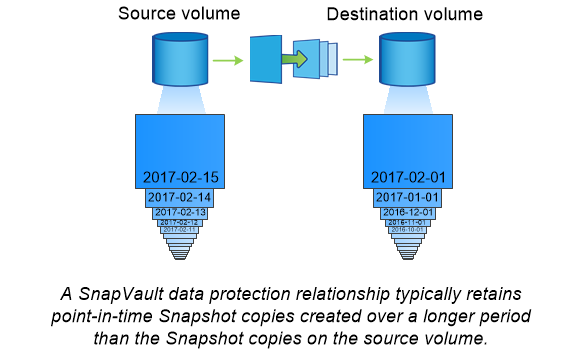SnapVault archiving basics
SnapVault is archiving technology, designed for disk-to-disk Snapshot copy replication for standards compliance and other governance-related purposes. In contrast to a SnapMirror relationship, in which the destination usually contains only the Snapshot copies currently in the source volume, a SnapVault destination typically retains point-in-time Snapshot copies created over a much longer period.
You might want to keep monthly Snapshot copies of your data over a 20-year span, for example, to comply with government accounting regulations for your business. Since there is no requirement to serve data from vault storage, you can use slower, less expensive disks on the destination system.
SnapMirror and SnapVault share the same command infrastructure. You specify which method you want to use when you create a SnapMirror policy. Both methods require peered clusters and peered SVMs.
The figure below illustrates SnapVault data protection relationships.

How SnapVault data protection relationships are initialized
As with SnapMirror, SnapVault performs a baseline transfer the first time you invoke it. The SnapMirror policy for the relationship defines the contents of the baseline and any updates.
A baseline transfer under the default SnapVault policy XDPDefault makes a Snapshot copy of the source volume, then transfers that copy and the data blocks it references to the destination volume. Unlike SnapMirror, SnapVault does not include older Snapshot copies in the baseline.
How SnapVault data protection relationships are updated
Updates are asynchronous, following the schedule you configure. The rules you define in the policy for the relationship identify which new Snapshot copies to include in updates and how many copies to retain. The labels defined in the policy (“monthly,” for example) must match one or more labels defined in the Snapshot policy on the source. Otherwise, replication fails.
At each update under the XDPDefault policy, SnapMirror transfers Snapshot copies that have been made since the last update, provided they have labels matching the labels defined in the policy rules. In the following output from the snapmirror policy show command for the XDPDefault policy, note the following:
- Create Snapshot is
false
, indicating that XDPDefault does not create a Snapshot copy when SnapMirror updates the relationship. - XDPDefault has rules
daily
andweekly
, indicating that all Snapshot copies with matching labels on the source are transferred when SnapMirror updates the relationship.
cluster_dst::> snapmirror policy show -policy XDPDefault -instance
Vserver: vs0
SnapMirror Policy Name: XDPDefault
SnapMirror Policy Type: vault
Policy Owner: cluster-admin
Tries Limit: 8
Transfer Priority: normal
Ignore accesstime Enabled: false
Transfer Restartability: always
Network Compression Enabled: false
Create Snapshot: false
Comment: Default policy for XDP relationships with daily and weekly
rules.
Total Number of Rules: 2
Total Keep: 59
Rules: SnapMirror Label Keep Preserve Warn Schedule Prefix
---------------- ---- -------- ---- -------- ------
daily 7 false 0 - -
weekly 52 false 0 - -